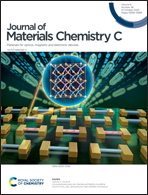Realizing red/orange emission of Eu2+/Ce3+ in La26−xSrxSi41Ox+1N80−x (x = 12.72–12.90) phosphors for high color rendition white LEDs†
Abstract
Rare-earth-activated phosphors play key roles in controlling the optical quality of phosphor-converted white light-emitting diodes (pc-wLEDs), but it is still a challenge to discover new phosphors with interesting properties or structures. In this work, we applied the single-particle-diagnosis approach to screen and find phosphors in a multi-nary system La–Sr–Si–O–N, and discovered broadband red- or orange-emitting La26−xSrxSi41Ox+1N80−x:Eu2+/Ce3+ (x = 12.72–12.90) phosphors. The single-crystal structure refinement results show that La13.1Sr12.9Si41O13.9N67.1 (x = 12.9) crystallizes in the hexagonal system (space group P![[6 with combining macron]](https://www.rsc.org/images/entities/char_0036_0304.gif) , No. 174, Z = 3) with a = b = 17.3506 (5) Å, c = 22.4052 (6) Å. The crystal structure of La26−xSrxSi41Ox+1N80−x consists of three-dimensional frameworks formed by edge-, corner- and face-sharing Si(O,N)4 tetrahedra, where 23 independent and disordered La/Sr atoms are embedded in one unit cell. Under 450 nm excitation, the Eu2+-doped sample shows broad band red emission (λem = 643 nm, full-width at half maximum (FWHM) = 3477 cm−1 (142 nm)), and the Ce3+-doped one gives an orange emission (λem = 568 nm, FWHM = 4700 cm−1 (155 nm)). This makes La26−xSrxSi41Ox+1N80−x:Eu2+/Ce3+ an interesting phosphor for high color rendering pc-wLEDs, and an additional example for exploring the structure–property relations.
, No. 174, Z = 3) with a = b = 17.3506 (5) Å, c = 22.4052 (6) Å. The crystal structure of La26−xSrxSi41Ox+1N80−x consists of three-dimensional frameworks formed by edge-, corner- and face-sharing Si(O,N)4 tetrahedra, where 23 independent and disordered La/Sr atoms are embedded in one unit cell. Under 450 nm excitation, the Eu2+-doped sample shows broad band red emission (λem = 643 nm, full-width at half maximum (FWHM) = 3477 cm−1 (142 nm)), and the Ce3+-doped one gives an orange emission (λem = 568 nm, FWHM = 4700 cm−1 (155 nm)). This makes La26−xSrxSi41Ox+1N80−x:Eu2+/Ce3+ an interesting phosphor for high color rendering pc-wLEDs, and an additional example for exploring the structure–property relations.



 Please wait while we load your content...
Please wait while we load your content...